Byron Cummings and Emil Haury
at Double Adobe

Early investigations into the Pleistocene archaeology of Arizona were led by Byron Cummings, first Head of the Department of Archaeology. Between 1926 and 1931, Cummings investigated mammoths and other fossil bone finds from southeastern Arizona , including what he believed to be a pair of Pleistocene human burials from Cienega Creek. Although poorly documented, these discoveries led him to speculate that people had been in Arizona for 50,000 years (Cummings 1928).
The best documented example of Cummings' Paleoindian research occurred at the Double Adobe site. In October of 1926, just three months after the first human artifact was uncovered at the Folsom site, Cummings led four students to Whitewater Draw. Discovered by a schoolboy, the Double Adobe site contained the skull of a mammoth overlying a sand layer containing milling stones and handstones. This situation received only local attention until Ted Sayles and Ernst Antevs initiated an intensive survey of the draw in 1936 and named the Archaic-period Cochise culture (Sayles and Antevs 1941). The association of groundstones with extinct fauna eventually attracted the scrutiny of Gordon Willey and Philip Phillips (1958).
Among the students who assisted Cummings at Double Adobe was Emil Haury. In response to criticisms aimed at the stratigraphic associations at Double Adobe, Haury (1960) wrote,
As one of several who participated in the 1926 excavations of the mammoth and who removed a horse jaw amidst artifacts in the deeper layer, as well as numerous bones in later years from the same layer, I feel obligated to try to answer the questions voiced and to stave off the rejection of what I regard to be valid evidence.
Haury certainly entertained the possibility that mammoth hunters and plant gatherers were the same people following different seasonal pursuits, a prospect that he maintained for the duration of his career (Haury 1986:436-440). Continued scrutiny about the site eventually led to Michael Waters' reinvestigation. Returning to the site in 1983, Waters concluded that Cummings' mammoth was redeposited with sediments containing the earliest traces of the Cochise culture (Waters 1986).
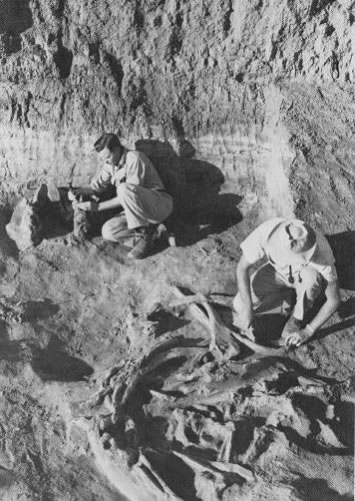
Emil Haury at Ventana Cave, Naco, and
Lehner Ranch
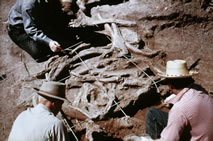
The mammoth remains are being
prepared for a plaster jacket
(Arizona State Museum).
Another of Haury's early forays into Paleoindian archaeology and geoarchaeology came in 1941 when he excavated Ventana Cave in southwestern Arizona , enlisting the aid of Julian Hayden and geomorphologist Kirk Bryan (Haury 1943, 1950). The deepest artifacts from Ventana Cave were recovered from a layer of volcanic debris that also contained Pleistocene horse, antelope, sloth, and other fossil and modern species. A projectile point from the volcanic debris layer was compared to Folsom and later to Clovis , but the assemblage was peculiar enough to warrant a separate name – the Ventana Complex. Radiocarbon dates from the volcanic debris layer indicated an age of about 11,300 BP.
A witness block and thorough sampling allowed Bruce Huckell and C. Vance Haynes to revisit the site stratigraphy and artifact assemblage in 1991. New radiocarbon dates and artifact analysis indicates that the volcanic debris layer was laid down between 10,500-8,800 BP, and that vertical turbation is responsible for the association of extinct fauna with stone tools.
Emil Haury's involvement with problematic Paleoindian sites ended in 1952 at Naco , Arizona , where Haury excavated the Naco mammoth site in Greenbush Draw (Haury at al. 1953). The site was reported to Haury by Marc Navarrete in September of 1951 after his father, Fred, found two Clovis points while uncovering the remains of a mammoth. Ernst Antevs and Ted Gladwin accompanied Haury to the site in November of 1951. After not finding additional artifacts in the cutbank, Antevs noted in his pocket journal that the archaeological situation was, “not very promising.”

mammoth bone at the Naco site, 1952
(Arizona State Museum).
Excavations were carried out April 14-18, 1952. In only five days, Haury recovered what remained of a single mammoth with seven Clovis points in direct association. The Naco site was the first Clovis-mammoth association to be identified after the Clovis type was recognized as typologically distinct and stratigraphically separated from the younger Folsom type. The work at Naco also witnessed Ernst Antevs' “geologic-climatic” method of stratigraphic correlation and dating (e.g., Antevs 1955), resulting in a remarkably accurate age estimate of 10,000 to 11,000 years old.
Soon after the work at Naco, Haury excavated the Lehner mammoth site near Hereford , Arizona . Nearly two months of fieldwork in 1955 and 1956 yielded the remains of nine mammoths, the isolated remains of horse, bison, and tapir, 13 Clovis points, eight flake tools, one chopping tool, a small amount of flake debris, and two hearths (Haury et al. 1959). A distinctive black clay layer, coined the “Lehner swamp soil,” buried these deposits and the mammoth remains. Antevs (1959) associated the “swamp soil” with a subhumid climate and ponding, but inaccurate radiocarbon dates prohibited an absolute date for the interval. Vance Haynes later renamed it the “black mat” and several more recent radiocarbon dates indicate that it formed between 9,800 and 10,800 BP (Haynes 2007).

mandible and mammoth bone at the Lehner site, 1955 (Arizona State Museum).

The Program in Geochronology
The Program in Geochronology developed from the early work of A.E. Douglas in dendrochronology. He brought his pioneering interests and activities from Flagstaff to the UA in 1937. It grew to include studies in archaeology, botany, geology, paleontology, and paleoclimatology. A radiocarbon laboratory was installed at the University in 1952, the same year that a committee was formed to direct studies in this field. The UA lab was one of the first in the country, established just two years after the method was initially developed. In 1957 Paul Damon joined the Department of Geosciences and became Director of the radiocarbon lab. His arrival heralded decades of primary research into radiocarbon dating and isotope geochemistry that continues today (http://www.geo.arizona.edu/research/iso_lab.htm). Damon along with Austin Long, Vance Haynes, their students and other colleagues worked on a variety of archaeologically and geoarchaeologically significant topics of dating various materials in an array of depositional settings around the world. In 1981, the Accelerator Mass-Spectrometry radiocarbon lab (http://www.physics.arizona.edu/ams/) was established as a joint project between the Departments of Geosciences and Physics. This was one of the first AMS 14C labs in the world.
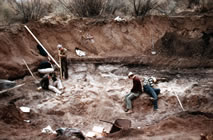
with the bone bed well exposed
(Arizona State Museum).
Enter C. Vance Haynes, Jr.

Lehner Mammoth site.
Through the 1950s C. Vance Haynes, Jr., combined his long avocational interest in archaeology with his training and career work in geology (though the latter was in engineering geology and metamorphic petrology) (C.V. Haynes, pers. comm. 1999). A series of fortuitous military postings in Albuquerque, Austin, and Fairbanks, coupled with his choice of the Colorado School of Mines near Denver for an undergraduate degree, brought him into contact with some of the leading Paleoindian archaeologists of the day, including Frank Hibben, Fred Wendorf, Alex Krieger, E.H. Sellards, Glen Evans, Dave Hopkins, Marie Wormington, Henry and Cynthia Irwin, and George Agogino. He eventually entered the University of Arizona , attracted by the Program in Geochronology and Haury's Paleoindian studies, to pursue graduate work on Paleoindian geochronology, earning his PhD in Geosciences in 1965. As a graduate student, he and George Agogino began a systematic search for charcoal among the many Paleoindian sites on the Great Plains , personally processing the samples in the then new UA radiocarbon laboratory. Their work resulted in the first reliable date for Folsom based on work at the Lindenmeier site in Colorado (Haynes and Agogino 1960), the first reliable age control for the Dent site, Colorado, and the Agate Basin site, Wyoming (Haynes 1964), and a landmark predoctoral paper in Science (Haynes 1964) that first laid out an accurate Paleoindian chronology based on careful application (mostly by him) of the then still relatively new radiocarbon method. Our understanding of both Clovis and Folsom chronology began with that paper.
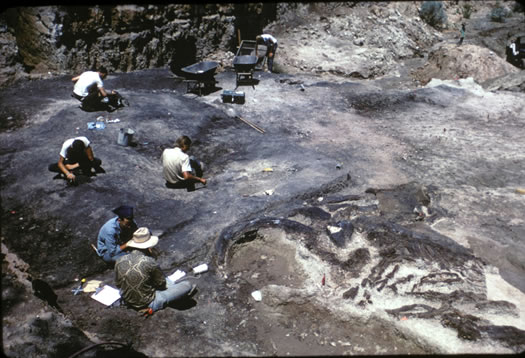
Being one of the few geologists interested in archaeological questions at the same time that environmental archaeology was taking off, and having been in contact with the Who's Who of Paleoindian studies, he quickly became involved in a variety of projects in the early 1960s such as Hell Gap (Haynes et al. 1965; Irwin-Williams et al. 1973) and Sister's Hill in Wyoming (Haynes and Grey 1965), and was invited by Fred Wendorf to join the High Plains Paleoecology Project (HPPP). This project was also Vance's entre to work at the Clovis site (Blackwater Draw Locality 1). All of these events more or less marked the beginning of Vance's professional career in geoarchaeology and Paleoindian studies and resulted in a series of significant papers in the 1960s, 1970s, and 1980s (e.g., Haynes 1966, 1970, 1973, 1980).
Vance's initial work at Hell Gap and Clovis in the early 1960s were milestones in Great Plains geoarchaeology and Paleoindian studies. Both sites contain long and extensive records of Paleoindian habitation, each providing a more or less complete record of the regional Paleoindian sequence. The work at Hell Gap was one of the single biggest advances in understanding the Northern Plains Paleoindian chronology following the development of the radiocarbon dating method itself. Until the Hell Gap work, the stratigraphic relationships of the Paleoindian record in the region largely were inferred based on data elsewhere, especially the Southern Great Plains . The results from Hell Gap combined with his work at Sister's Hill and the U.P. mammoth site also provided the outlines for the first regional model of late Quaternary geoarchaeology in the Wyoming Basin and Northern Great Plains (Haynes 1968).
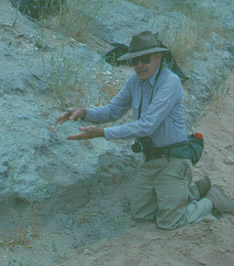
(V. Holliday)
At about the same time, Vance's initial work at Clovis resulted in the first well-dated Paleoindian and post-Paleoindian archaeological sequence for the Southern Great Plains (Haynes 1967, 1975; Haynes and Agogino 1966). Because this work was part of the HPPP, it also formed a stratigraphic and geochronologic basis for refining and revising the regional Paleoindian geoarchaeological stratigraphic sequence.
Hell Gap and Clovis were and are spectacular sites in their own right, but Vance brought something unique to his work in the early 1960s: careful attention to microstratigraphic detail. Vance's microstratigraphy focuses not just on sedimentology and depositional environments but on archaeological relationships and radiocarbon sampling. Attention to detail in recording and sampling is not unusual in archaeology or in the geosciences, but Vance brought a unique combination of a solid training and experience in field geology, a passion for archaeology, and an understanding of radiocarbon geochemistry.
More generally, Vance's early work at Hell Gap, Clovis, and other sites on the Great Plains was the first and is still one of the few regional geoarchaeological investigations where the same individual studied both the site and regional stratigraphy, assessed the archaeology, and both collected and processed the radiocarbon samples. This has provided him with a perspective at a subcontinental scale that is probably unique in all of North American geoarchaeology.
Back to the San Pedro Valley

(C. V. Haynes)
By the late 1960s, Vance was well established as one of the country's leading (and few) geoarchaeologists and Paleoindian researchers. During this time he began his own long-term interdisciplinary archaeological project in the San Pedro Valley of Arizona (e.g., Haynes 1981, 1982, 1987). In the mid-1960s, during a systematic search of the San Pedro Valley for additional mammoth sites as well as pollen localities, Vance Haynes and Peter Mehringer, then both graduate students at UA, discovered and tested a series of sites in the area.
In the winter of 1966, Louis Escapule discovered the partial remains of a large mammoth eroding from the surface of a tributary to the San Pedro River . The Escapule mammoth rested on an eroded marl surface and was buried by “black mat” deposits before Holocene erosion removed portions of the site. Mr. Escapule exposed, photographed, and removed two Clovis points associated with the animal's ribs, but professional excavations in 1967 did not recover further evidence of this association (Hemming and Haynes 1969).
The most significant archaeological find in the valley, the Murray Springs site, was excavated over the course of six field seasons between 1966 and 1971, with limited geochronological, paleoenvironmental, and archaeological exploration and research still in progress. The site was exposed by headward arroyo cutting sometime between 1958 and the time of discovery in 1965. It provides a remarkable record of Clovis hunting activities as reflected in both mammoth and bison kill areas, and an accompanying camp area. A large assemblage of projectile points, flake tools, and thousands of flakes from discreet knapping locales attest to exceptional preservation beneath the “black mat,” as do sealed mammoth track impressions and a presumed shaft straightener fashioned from carved mammoth bone.
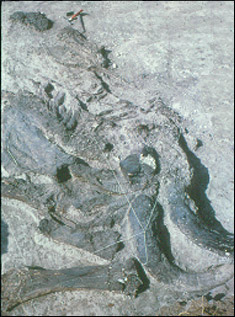
(C. V. Haynes)
The Bigger Picture
The decades of the 1970s, 1980s, and 1990s saw Haynes involved in addressing similar sorts of research questions in familiar patterns. For example, he continued using microstratigraphy and careful application of radiocarbon dating (the AMS method in particular) to clarify artifact chronologies. Radiocarbon dating of the Mill Iron bone bed (in Montana ) and analysis of the associated Goshen artifacts has raised a number of questions regarding the age and typological relationships between the Goshen style of the Northern Great Plains and the Plainview style of the Southern Great Plains (Frison et al. 1996). His microstratigraphic work at the Clovis site (Haynes 1995) has shown how short the Clovis-Folsom transition was, something he first proposed in 1964. Additional work at Clovis , Folsom, and Lindenmeier, combined with data from the San Pedro Valley and from other research on the Great Plains tightened the age range for Clovis to between 11,200 and 10,900 radiocarbon yrs BP, and for Folsom to between 10,900 and 10,300 radiocarbon years BP (Haynes et al. 1992; Haynes 1993). Significantly, these age ranges, based on dozens of dates, are not substantially different from the original age ranges of 11,500 to 11,000 for Clovis and 11,000 to 10,000 for Folsom, published in the 1964 Science article based on a handful of samples from a few sites. The dating of Clovis and Folsom also bring up the thorny issue of radiocarbon calibration (Taylor et al. 1996). Another noteworthy aspect of Vance's work is that a quarter century ago Vance predicted the possibility of an atmospheric accordion effect on our Paleoindian time scale (Haynes 1971).
In the 1960s Vance began research into geoarchaeology of middle and late Paleolithic sites in the Western Desert of Egypt. In four decades of research he delved into such diverse topics as the geochronology of playas, landscape evolution, remote sensing, processes of sand movement (literally following in the footsteps of the renowned desert naturalist Ralph Bagnold), and climate change, and documented previously unknown Paleolithic sites and the historic camps of early desert travelers. Some of Vance's Egyptian work and that of colleagues and students is presented in a special issue of the journal Geoarchaeology (January 2001, volume 16, number 1).
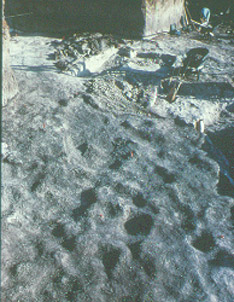
Vance Haynes retired from the UA in 1999, but continues an active program of research, including, among other commitments, a summary publication of over three decades of work in the San Pedro Valley . The establishment of the Argonaut Archaeological Research Fund was a direct outgrowth of Vance Haynes' long term Paleoindian research program and the search for his replacement. Although AARF is focused explicitly on the Southwest, other Paleoindian archaeological and geoarchaeological research is underway by faculty and students.
References Cited
Antevs, Ernst (1955) Geologic-climatic Dating in the West. American Antiquity 20:317-335.
Antevs, Ernst (1959) Geological Age of the Lehner Mammoth Site. American Antiquity 25(1):31-34.
Cummings, Byron (1928) Cochise of Yesterday. Arizona Old and New I, no. 4:9-10,25-28.
Frison, George, C. Vance Haynes, Jr., and Mary Lou Larson (1996) Discussion and Conclusions. In The Mill Iron Site, edited by G.C. Frison, pp. 205-216. University of New Mexico Press, Albuquerque.
Haury, Emil W. (1943) The Stratigraphy of Ventana Cave. American Antiquity 8:218-223.
Haury, Emil W. (1950) The Stratigraphy and Archaeology of Ventana Cave. University of Arizona Press and University of New Mexico Press, Tucson, Arizona, and Albuquerque, New Mexico.
Haury, Emil W. (1953) Artifacts with Mammoth Remains, Naco , Arizona : Discovery of the Naco Mammoth and the Associated Projectile Points. American Antiquity 19:1-14.
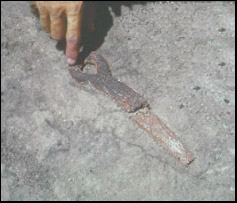
at Murray Springs. (C. V. Haynes)
Haury, Emil W. (1960) Association of Fossil Fauna and Artifacts of the Sulphur Spring Stage, Cochise Culture. American Antiquity 25(4):609-610.
Haury, Emil W. (1986) Thoughts After Sixty Years As a Southwestern Archaeologist. In Emil W. Haury's Prehistory of the American Southwest, edited by J. Jefferson Reid and David E. Doyel, pp. 435-464. University of Arizona Press, Tucson .
Haury, Emil W., E.B. Sayles, and W.W. Wasley (1959) The Lehner Mammoth Site, Southeastern Arizona . American Antiquity 25:2-32.
Haynes, C. Vance, Jr. (1964) Fluted Projectile Points: Their Age and Dispersion. Science 145: 1408-1413.
Haynes, C. Vance, Jr. (1966) Elephant Hunting in North America . Scientific American 214:104-112.
Haynes, C. Vance, Jr. (1967) Carbon-14 Dates and Early Man in the New World . In Pleistocene Extinctions: The Search for a Cause, edited by P.S. Martin and H.E. Wright, Jr., pp. 267-286. Yale University Press, New Haven , Connecticut .
Haynes, C. Vance, Jr. (1968) Geochronology of Late-Quaternary Alluvium. In Means of Correlation of Quaternary Successions, edited by R.B. Morrison and H.E. Wright, Jr., pp. 591-631. University of Utah Press, Salt Lake City .
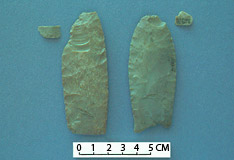
(C. V. Haynes)
Haynes, C. Vance, Jr. (1970) Geochronology of Man-mammoth Sites and Their Bearing on the Origin of the Llano Complex. In Pleistocene and Recent Environments of the Central Great Plains , edited by W. Dort and J.K. Jones, pp. 77-92. University of Kansas Press, Lawrence.
Haynes, C. Vance, Jr. (1971) Time, Environment, and Early Man. Arctic Anthropology 8:3-14.
Haynes, C. Vance, Jr. (1973) The Calico Site: Artifacts or Geofacts? Science 181:305-310.
Haynes, C. Vance, Jr. (1975) Pleistocene and Recent Stratigraphy. In Late Pleistocene Environments of the Southern High Plains, edited by F. Wendorf and J.J. Hester, pp. 57-96. Fort Burgwin Research Center , Taos , New Mexico .
Haynes, C. Vance, Jr. (1980) The Clovis Culture. Canadian Journal of Anthropology 1:115-121.
Haynes, C. Vance, Jr. (1981) Geochronology and Paleoenvironments of the Murray Springs Clovis Site, Arizona . National Geographic Society Research Reports 13:243-251.
Haynes, C. Vance, Jr. (1982) Archeological Investigations at the Lehner Site, Arizona, 1974-1975. National Geographic Society Research Reports 14:325-334.
Haynes, C. Vance, Jr. (1986) Discovering Early Man in Arizona . In Emil W. Haury's Prehistory of the American Southwest, edited by J.J. Reid and D.E. Doyel, pp. 75-77. University of Arizona Press, Tucson .
Haynes, C. Vance, Jr. (1987) Curry Draw, Cochise County , Arizona : A Late Quaternary Stratigraphic Record of Pleistocene Extinction and Paleo-Indian Activities. In Cordilleran Section, edited by M.L. Hill, pp. 23-28. Geological Society of America Centennial Field Guide Volume 1. Geological Society of America , Boulder , Colorado .
Haynes, C. Vance, Jr. (1993) Clovis-Folsom Geochronology and Climatic Change. In From Kostenki to Clovis : Upper Paleolithic - Paleo-Indian Adaptations, edited by O. Soffer and N.D. Praslov, pp. 219- 236. Plenum Press, New York
Haynes, C. Vance, Jr. (1995) Geochronology of Paleoenvironmental Change, Clovis Type Site, Blackwater Draw, New Mexico. Geoarchaeology 10:317-388.
Haynes, C. Vance, Jr. (2007) Radiocarbon dating at Murray Springs and Curry Draw. In Murray Springs: A Clovis Site with Multiple Activity Areas in the San Pedro Valley, Arizona, edited by C. Vance Haynes, Jr., and Bruce B. Huckell, pp. 229-239. University of Arizona Press, Tucson .
Haynes, C. Vance, Jr. and George A. Agogino (1960) Geological Significance of a New Radiocarbon Date from the Lindenmeier Site. The Denver Museum of Natural History, Proceedings 9, Denver .
Haynes, C. Vance, Jr. and George A. Agogino (1966) Prehistoric Springs and Geochronology of the Clovis Site, New Mexico . American Antiquity 31:812-821.
Haynes, C. Vance, Jr. and Donald C. Grey (1965) The Sister's Hill Site and its Bearing on the Wyoming Postglacial Alluvial Chronology. Plains Anthropologist 10:196-211.
Haynes, C. Vance, Jr., Henry T. Irwin, Cynthia Irwin-Williams, and George A. Agogino (1965) Hell Gap Archaeological Site, Wyoming. INQUA, Guidebook for Field Conference E, Northern and Middle Rocky Mountains , pp. 17-20.
Haynes, C. Vance, Jr., R.P. Beukens, A.J.T. Jull, and Owen K. Davis (1992) New Radiocarbon Dates for Some Old Folsom Sites: Accelerator Technology. In Ice Age hunters of the Rockies , edited by D.J. Stanford and J.S. Day, pp. 83-100. Denver Museum of Natural History and University Press of Colorado , Denver .
Haynes, C. Vance, Jr., Dennis J. Stanford, Margaret M. Jodry, Joanne Dickenson, John L. Montgomery, Philip H. Shelley, Irwin Rovner, and George A. Agogino (1999) A Clovis Well at the Type Site 11,500 B.C.: The Oldest Prehistoric Well in America. Geoarchaeology 14:455-470.
Hemmings, E. Thomas and C. Vance Haynes, Jr. (1969) The Escapule Mammoth and Associated Projectile Points, San Pedro Valley , Arizona . Journal of the Arizona Academy of Science 5:184-188.
Huckell, Bruce B., and C. Vance Haynes, Jr. (2003) The Ventana Complex: New Dates and New Ideas on Its Place in Early Holocene Western Prehistory. American Antiquity 68(2):353-372
Irwin-Williams, Cynthia, Henry T. Irwin, George A. Agogino, and C. Vance Haynes, Jr. (1973) Hell Gap: Paleo-Indian Occupation on the High Plains. Plains Anthropologist 18:40-53.
Sayles, Edward B, and Ernst Antevs (1941) The Cochise Culture. Medallion Papers 29. Gila Pueblo Archaeological Foundation, Globe, Arizona .
Taylor, R.E., C.V. Haynes, Jr., and M. Stuiver (1996) Clovis and Folsom Age Estimates: Stratigraphic Contexts and Radiocarbon Calibration. Antiquity 70:515-525.
Waters, Michael R. (1986) The Geoarchaeology of Whitewater Draw. Anthropological Papers 45. University of Arizona Press, Tucson .
Willey, Gordon R., and Philip Phillips (1958) Method and Theory in American Archaeology. University of Chicago Press, Chicago.
